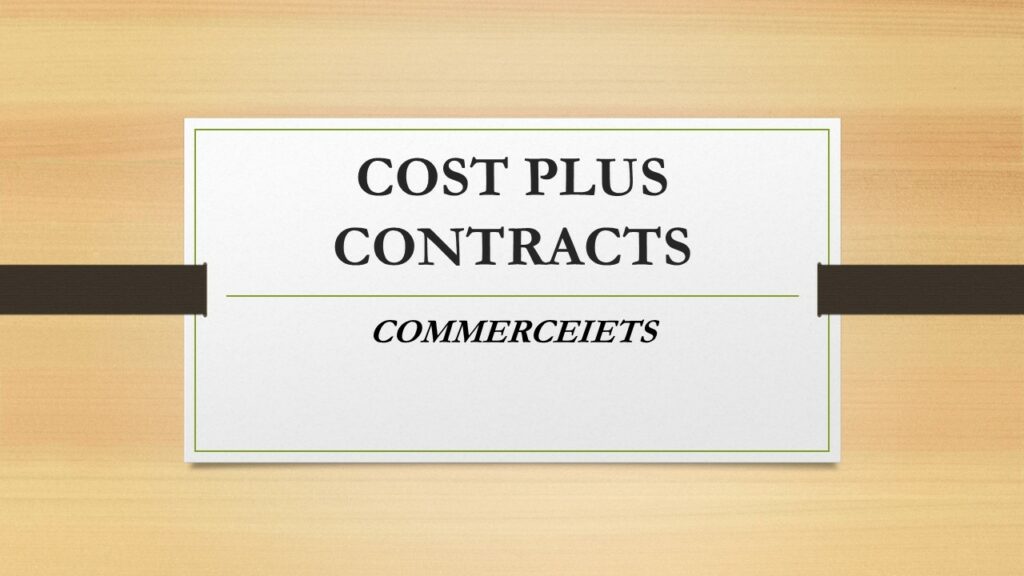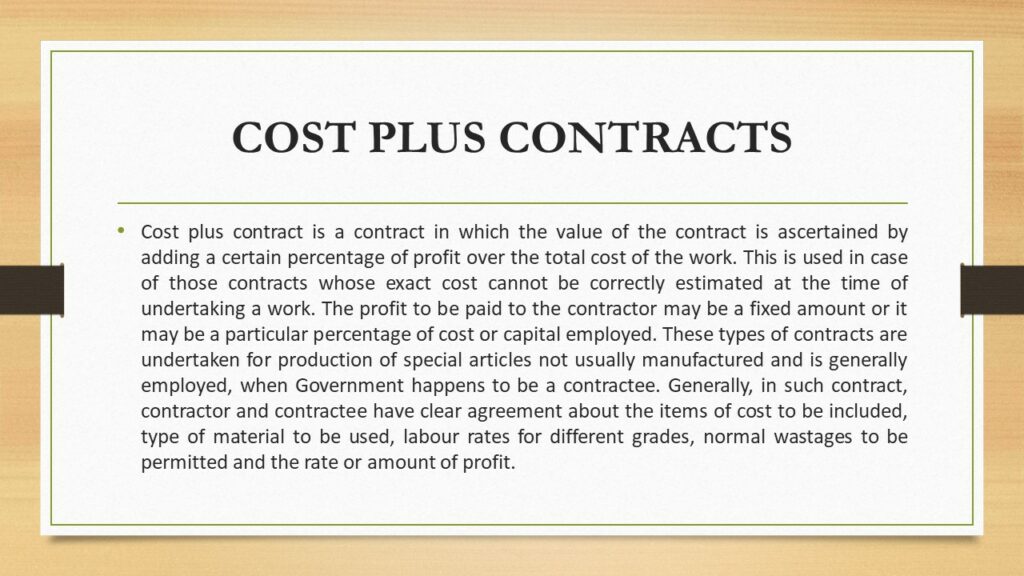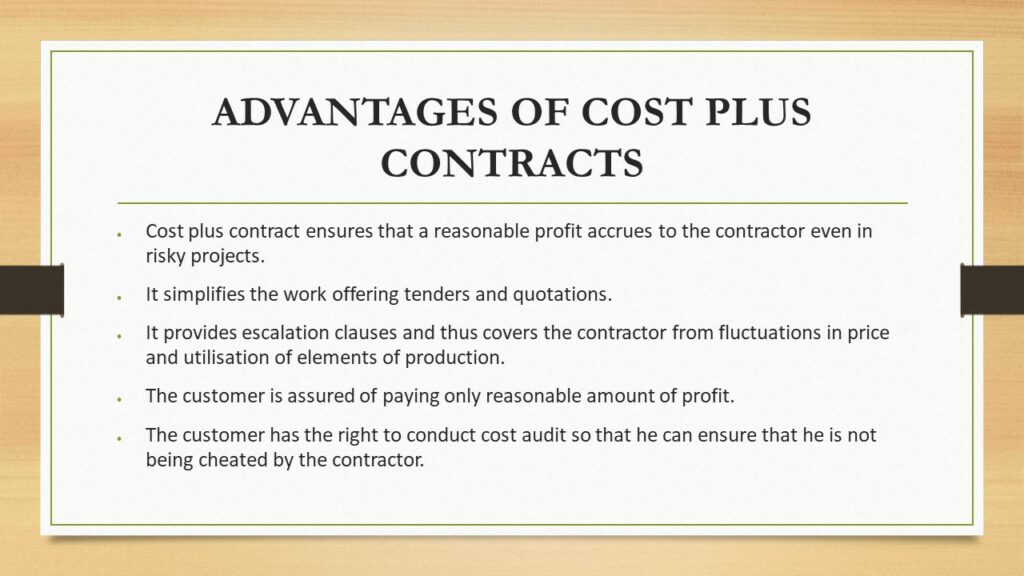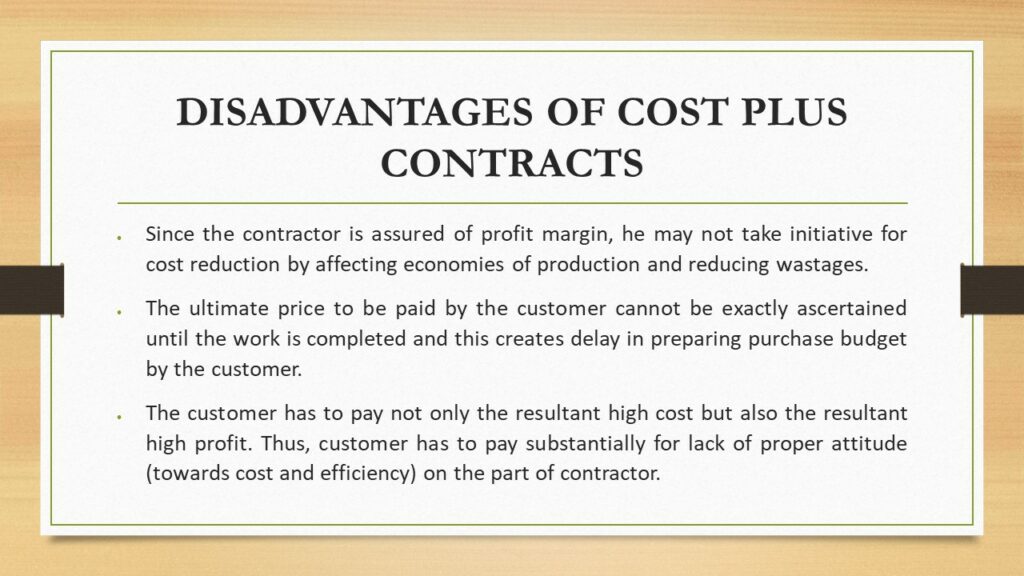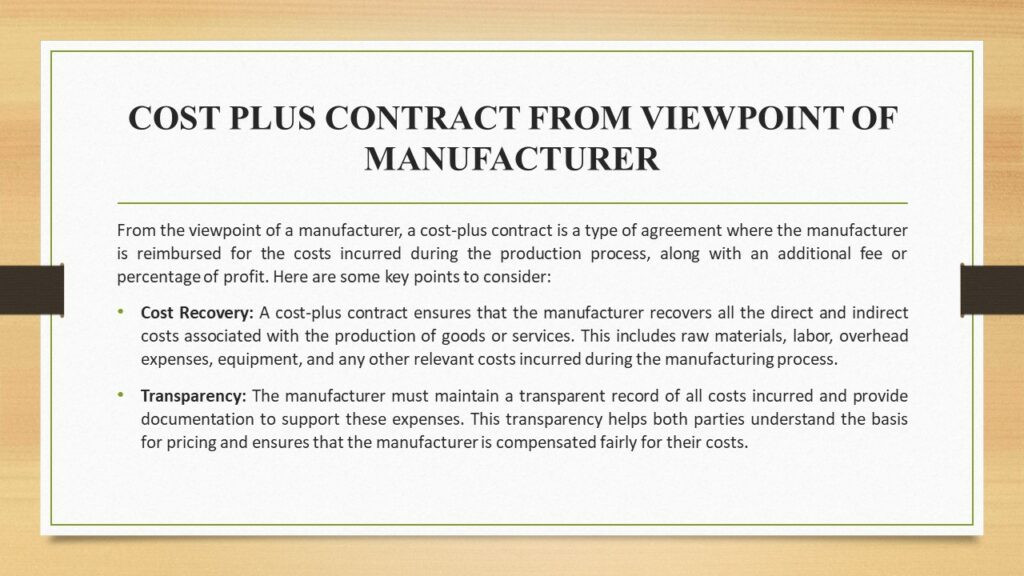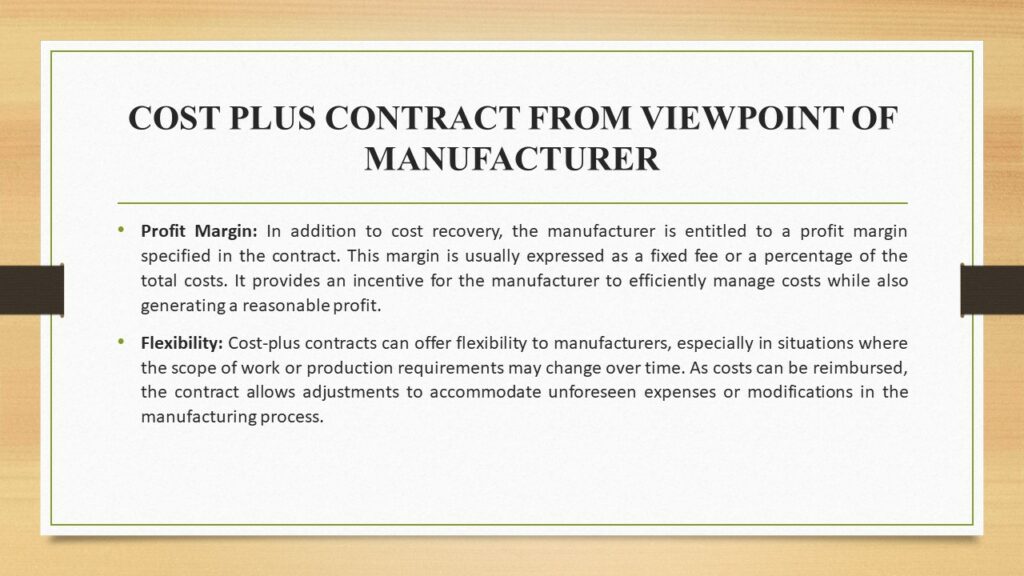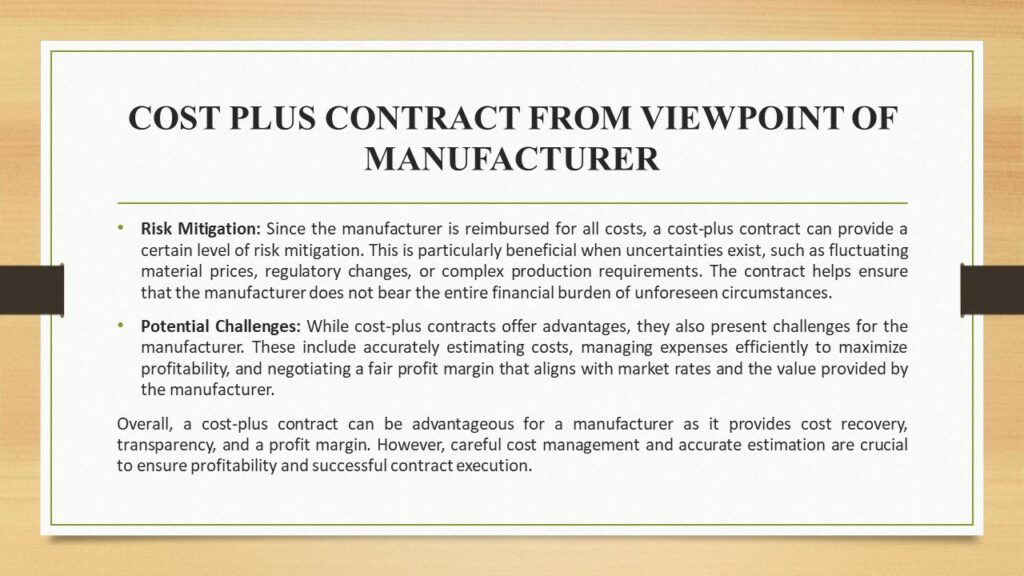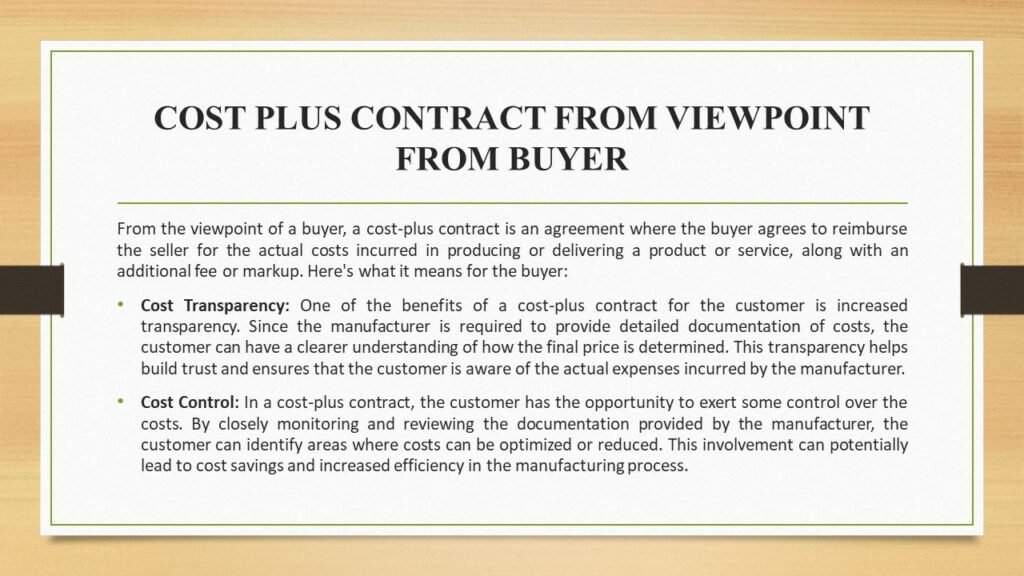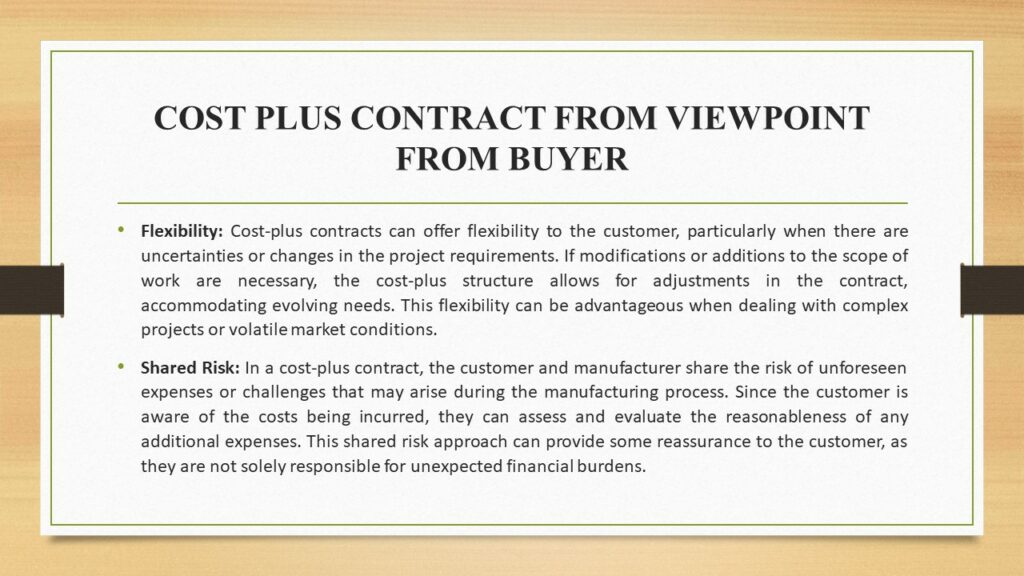COST PLUS CONTRACTS IN CONTRACT COSTING
Cost plus contract is a contract in which the value of the contract is ascertained by adding a certain percentage of profit over the total cost of the work. This is used in case of those contracts whose exact cost cannot be correctly estimated at the time of undertaking a work. The profit to be paid to the contractor may be a fixed amount or it may be a particular percentage of cost or capital employed.
These types of contracts are undertaken for production of special articles not usually manufactured and is generally employed, when Government happens to be a contractee. Generally, in such contract, contractor and contractee have clear agreement about the items of cost to be included, type of material to be used, labour rates for different grades, normal wastages to be permitted and the rate or amount of profit.
Advantages of cost-plus contract
- Cost plus contract ensures that a reasonable profit accrues to the contractor even in risky projects.
- It simplifies the work offering tenders and quotations.
- It provides escalation clauses and thus covers the contractor from fluctuations in price and utilisation of elements of production.
- The customer is assured of paying only reasonable amount of profit.
- The customer has the right to conduct cost audit so that he can ensure that he is not being cheated by the contractor.
Disadvantages of cost-plus contract system
Despite the advantages mentioned above cost plus contract system has the following disadvantages:
- Since the contractor is assured of profit margin, he may not take initiative for cost reduction by affecting economies of production and reducing wastages.
- The ultimate price to be paid by the customer cannot be exactly ascertained until the work is completed and this creates delay in preparing purchase budget by the customer.
- The customer has to pay not only the resultant high cost but also the resultant high profit. Thus, customer has to pay substantially for lack of proper attitude (towards cost and efficiency) on the part of contractor.
COST PLUS CONTRACT FROM VIEWPOINT OF MANUFACTURER
From the viewpoint of a manufacturer, a cost-plus contract is a type of agreement where the manufacturer is reimbursed for the costs incurred during the production process, along with an additional fee or percentage of profit. Here are some key points to consider:

- Cost Recovery: A cost-plus contract ensures that the manufacturer recovers all the direct and indirect costs associated with the production of goods or services. This includes raw materials, labor, overhead expenses, equipment, and any other relevant costs incurred during the manufacturing process.
- Transparency: The manufacturer must maintain a transparent record of all costs incurred and provide documentation to support these expenses. This transparency helps both parties understand the basis for pricing and ensures that the manufacturer is compensated fairly for their costs.
- Profit Margin: In addition to cost recovery, the manufacturer is entitled to a profit margin specified in the contract. This margin is usually expressed as a fixed fee or a percentage of the total costs. It provides an incentive for the manufacturer to efficiently manage costs while also generating a reasonable profit.
- Flexibility: Cost-plus contracts can offer flexibility to manufacturers, especially in situations where the scope of work or production requirements may change over time. As costs can be reimbursed, the contract allows adjustments to accommodate unforeseen expenses or modifications in the manufacturing process.
- Risk Mitigation: Since the manufacturer is reimbursed for all costs, a cost-plus contract can provide a certain level of risk mitigation. This is particularly beneficial when uncertainties exist, such as fluctuating material prices, regulatory changes, or complex production requirements. The contract helps ensure that the manufacturer does not bear the entire financial burden of unforeseen circumstances.
- Potential Challenges: While cost-plus contracts offer advantages, they also present challenges for the manufacturer. These include accurately estimating costs, managing expenses efficiently to maximize profitability, and negotiating a fair profit margin that aligns with market rates and the value provided by the manufacturer.
Overall, a cost-plus contract can be advantageous for a manufacturer as it provides cost recovery, transparency, and a profit margin. However, careful cost management and accurate estimation are crucial to ensure profitability and successful contract execution.
COST PLUS CONTRACT FROM VIEWPOINT FROM BUYER
From the viewpoint of a buyer, a cost-plus contract is an agreement where the buyer agrees to reimburse the seller for the actual costs incurred in producing or delivering a product or service, along with an additional fee or markup. Here’s what it means for the buyer:

- Cost Transparency: One of the benefits of a cost-plus contract for the customer is increased transparency. Since the manufacturer is required to provide detailed documentation of costs, the customer can have a clearer understanding of how the final price is determined. This transparency helps build trust and ensures that the customer is aware of the actual expenses incurred by the manufacturer.
- Cost Control: In a cost-plus contract, the customer has the opportunity to exert some control over the costs. By closely monitoring and reviewing the documentation provided by the manufacturer, the customer can identify areas where costs can be optimized or reduced. This involvement can potentially lead to cost savings and increased efficiency in the manufacturing process.
- Flexibility: Cost-plus contracts can offer flexibility to the customer, particularly when there are uncertainties or changes in the project requirements. If modifications or additions to the scope of work are necessary, the cost-plus structure allows for adjustments in the contract, accommodating evolving needs. This flexibility can be advantageous when dealing with complex projects or volatile market conditions.
- Shared Risk: In a cost-plus contract, the customer and manufacturer share the risk of unforeseen expenses or challenges that may arise during the manufacturing process. Since the customer is aware of the costs being incurred, they can assess and evaluate the reasonableness of any additional expenses. This shared risk approach can provide some reassurance to the customer, as they are not solely responsible for unexpected financial burdens.
- Potential Cost Overruns: One consideration for customers in a cost-plus contract is the possibility of cost overruns. If the manufacturing process encounters unforeseen challenges or if the manufacturer fails to efficiently manage costs, it can result in higher expenses for the customer. This risk underscores the importance of monitoring costs closely and maintaining open communication with the manufacturer.
- Profit Margin: Another aspect for customers to consider is the manufacturer’s profit margin in a cost-plus contract. While the customer benefits from transparency, it’s essential to negotiate a fair and reasonable profit margin. Ensuring that the profit percentage or fixed fee aligns with market rates and the value provided by the manufacturer is crucial to avoid overpaying for the services or goods.
In summary, a cost-plus contract offers customers increased transparency, cost control opportunities, and flexibility. However, customers need to actively monitor costs and negotiate a fair profit margin to mitigate the risks of potential cost overruns and ensure that they receive value for their investment.
